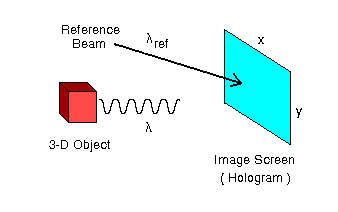User:Tohline/Appendix/CGH/ParallelAperturesHolograms
CGH: Relevance to Holograms
This chapter is intended primarily to replicate §I.C from the online class notes — see also an updated Table of Contents — that I developed in conjunction with a course that I taught in 1999 on the topic of Computer Generated Holography (CGH) for a subset of LSU physics majors who were interested in computational science.

|
|---|
| | Tiled Menu | Tables of Content | Banner Video | Tohline Home Page | |
Basic Concept
Okay, so what do §§I.A and I.B have to do with the numerical construction of a hologram? Well, this is best explained by borrowing an illustration from the Nishikawa et al. (1997) paper (redrawn here as Figure I.2), and comparing it with Figure I.1 from our §I.A.
| Figure I.2 |
|---|
 |
In general a hologram is made by combining light of wavelength, <math>~\lambda</math>, that is coming from the surface of a 3-dimensional object with coherent light from a reference beam of wavelength <math>~\lambda_\mathrm{ref}</math>. The interference pattern that is created on the "image screen" via the combination of these two separate sources of light is recorded as the hologram — usually in the form of an exposed piece of photographic film. Let's consider the behavior of these two sources of light, separately.
Light from the Object
See Also
- Updated Table of Contents
- Born, M. and Wolf, E. (1980) Principles of Optics, 3rd Edition. New York: Pergamon Press. [See especially their §§8.5 and 8.10.] A link to the 6th edition of this book can be found here.

|
|---|
|
© 2014 - 2021 by Joel E. Tohline |